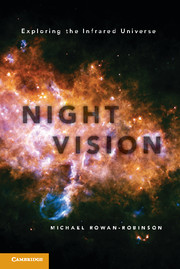Book contents
- Frontmatter
- Contents
- Preface
- 1 Introduction
- 2 William Herschel Opens Up the Invisible Universe
- 3 1800–1950
- 4 Dying Stars Shrouded in Dust and Stars Being Born
- 5 Birth of Submillimetre Astronomy
- 6 The Cosmic Microwave Background, Echo of the Big Bang
- 7 The Infrared Astronomical Satellite and the Opening Up of Extragalactic Infrared Astronomy
- 8 The Cosmic Background Explorer and the Ripples, the Wilkinson Microwave Anisotropy Probe and Dark Energy
- 9 Giant Ground-Based Near-Infrared and Submillimetre Telescopes
- 10 The Infrared Space Observatory and the Spitzer Space Telescope
- 11 Our Solar System’s Dusty Debris Disk and the Search for Exoplanets
- 12 The Future
- Epilogue
- Notes
- Credits for Illustrations
- Glossary
- Further Reading
- Bibliography
- Name Index
- Subject Index
1 - Introduction
Published online by Cambridge University Press: 05 March 2013
- Frontmatter
- Contents
- Preface
- 1 Introduction
- 2 William Herschel Opens Up the Invisible Universe
- 3 1800–1950
- 4 Dying Stars Shrouded in Dust and Stars Being Born
- 5 Birth of Submillimetre Astronomy
- 6 The Cosmic Microwave Background, Echo of the Big Bang
- 7 The Infrared Astronomical Satellite and the Opening Up of Extragalactic Infrared Astronomy
- 8 The Cosmic Background Explorer and the Ripples, the Wilkinson Microwave Anisotropy Probe and Dark Energy
- 9 Giant Ground-Based Near-Infrared and Submillimetre Telescopes
- 10 The Infrared Space Observatory and the Spitzer Space Telescope
- 11 Our Solar System’s Dusty Debris Disk and the Search for Exoplanets
- 12 The Future
- Epilogue
- Notes
- Credits for Illustrations
- Glossary
- Further Reading
- Bibliography
- Name Index
- Subject Index
Summary
Night vision – the ability of infrared light to penetrate dust and to light up the dusty universe – and also the new vision of the night sky, the universe that infrared astronomy has unveiled.
All astronomy starts from the night sky, the picture of the universe we see with our own eyes: the stars and constellations, the Milky Way. We have become used to the idea that there is a universe beyond the constellations, revealed by the giant telescopes of the astronomers. We can still imagine the Hubble Space Telescope to be a giant extension of our own eyes, and its images are still images made in visible light. Much harder to grasp is the universe that is revealed in invisible light, such as the infrared radiation that is the subject of this book. I’ve called the book Night Vision for two reasons. Firstly, infrared sensors and binoculars are already widely used to aid seeing in the dark, or night vision. And secondly, my goal is to try to make the infrared universe as familiar to you as the night sky, so that when you look out at the night sky you can also imagine what it would look like with infrared eyes, and therefore see the new vision of the night sky that the infrared gives us.
Above all, infrared astronomy is about the cool, dusty universe. Spread between the stars are tiny grains of dust, similar to sand and soot, and these absorb the light from stars and reradiate the energy as infrared radiation. There are dense clouds of gas and dust within which new stars are forming, and only with infrared light can we peer into them. Dying stars and massive black holes are often shrouded in dust, which shines in the infrared. And the cool bodies of the Solar System, planets, comets and asteroids are mainly radiating infrared light. In the infrared and submillimetre parts of the spectrum, we see galaxies in formation, undergoing violent bouts of star formation often caused by collisions between smaller fragments. And we see the cool glow left over by the hot fireball phase of the Big Bang itself.
- Type
- Chapter
- Information
- Night VisionExploring the Infrared Universe, pp. 1 - 14Publisher: Cambridge University PressPrint publication year: 2013



